Archive for the ‘#Duane Redford’ Tag
Hidy Ho Good Neighbors,
I pulled on the zipper for the last time as the fabric separated from the zipper and the zipper slide became lodged on the teeth. This is quite disconcerting as you’re knee deep in the river with no way to ensure your fly boxes aren’t going to become refugees. I hadn’t put more than one hundred guide trips on the waist pack I had and it was not showing the durability of previous gear from this manufacturer. Right then and there I decided to look into a different company to supply me another waist pack.
I’ve dealt with Umpqua gear in the past and was always satisfied with their performance and durability. My Tongass pack has never let me down as I have traveled the country with it, floated down several rivers, and even went for a few unplanned dips in the water with it on my back. Each instance, the pack has answered the durability bell and kept my expensive camera gear bone dry. I chose the Umpqua Ledges 650 waist pack in hopes that it would perform equally as well.
I just completed my sixtieth guide trip with the new pack and I like it very much. Every piece of gear in my old waist pack fit nicely in the Ledges 650 and left space for more gear than I typically carry. The large compartment has a leaf installed that helps keep your boxes separate and organized. Boxes slide in and out without issue. The pack is very comfortable to wear as the wide hip belt and shoulder straps are well padded and ergonomically justified. I especially like the plastic plate between where your hip and the bag meet. This allows the pack to freely slide around your torso without catching your waders and coming to a quick halt. This feature also provides a space between the pack and angler that keeps one from overheating on those hot summer afternoons.
The fabric is very durable, well stitched, and for what it’s worth, I like the color patterns. The zippers, ahh the zippers, my usual nemesis, have worked unerringly. The zippers are incredibly hard core, over-sized, and the pulls are reinforced, dipped, and will take a pretty good tug over and over again. Point blank durability at its finest.
Speaking of zippers, I do have a slight issue with the placement of the main compartment zipper. I have found it difficult at times to open or close that compartment because the zippers are in close proximity to my body and it’s tough to get the zipper started as you open or close the compartment. My opinion is that in the next generation, the designers may want to look at moving that zipper to the front of the bag. It’s not a show-stopper for me; it’s just that everything else with this pack is perfect, why not this too?
There are a couple of sleeper amenities on this pack that are worth their weight in gold. In the front there’s a great slot to carry forceps. I carry two spares in there. Also, under the used fly pad, there’s a neat compartment for whatever where I carry my thermometer, and below that is a zippered pocket where I carry extra leaders and my phone. I really like the compartments on the belt straps; I carry my weights, dry shake, extra lighter, and a fly puck in those. The front elastic pockets are a handy “get-to-fast” feature, and the compartments behind those are hard to overfill with tippet, pucks, or a cigar or two. This pack just has it going on.
Overall, I give this pack a very high rating, and I have only had it a third of a season. I expect it to age gracefully and keep me well supplied and comfortable for its entire life. Thanks Umpqua, for another fine piece of fly fishing gear.
Fear No Water!
Duane
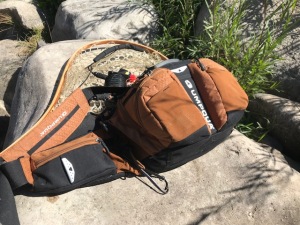

Hidy Ho Good Neighbors,
It was my eleventh summer and a group of my neighborhood buddies and I pooled our resources and engineering prowess to construct a very fine tree fort. This fort had everything, windows that opened and closed, quick exit trap doors, radio antennae, and a rope ladder. We were kings of the tree tops.
Our inaugural sleep-in night was upon us and just after we settled in for the evening someone tossed a lit smoke-bomb into our abode. I remember clicking on my flashlight and being surrounded by stinky blue smoke. We bailed out as quickly as possible, but the night was ruined. All that preparation and anticipation went right down the tubes. We were ticked.
I thought about the smoke-bomb incident the other day as I was standing in a well-known front range tailwater. I spend a lot of time guiding other fly fishers and every so often; I get to hit the river by myself, which is always a treat. I plan, re-rig my fly rods, spin a few special flies, and no matter how tired I am from the weeks work, I’m always up early and anxious to go.
I arrived much earlier than the other anglers, and had settled into a favorite run. This run has room for one angler, is choked with willows on the anglers backcast, and the perimeters can be easily reached with a decent roll cast. In other words, it’s a small section of river that a modest fly caster can cover top to bottom and bank to bank, without moving an inch.

Crowded rivers can lead to poor etiquette, unfortunately.
I had settled in, and put a couple small rainbows and one decent brown trout in the bottom of my net in around fifteen minutes. I smiled to myself after landing the last fish, relaxed a bit, and lit my pipe. Just then, I hear splashing below me in the run as two anglers step into the drink. They both look at me as I angle my head to the side, hitting them with a “What are you going to do?” non-verbal cue. One of the guys stops in his tracks, the other proceeds to place a roll cast into my run while trying to avoid eye-contact. His first cast, had I been in a drift, would have crossed my line!
I turned facing him and uttered, “Really, this is the best you can do?” He didn’t say a word, backed out and took his partner with him. I stood there for a minute shaking my head. I stripped out some line and readied for my next upstream presentation, when all of a sudden, those two knuckleheads bust through the willows on the bank above me, waded in, and began to fish. I could have easily cast over both of their lines. Smoke-bomb in the tree house!
I rigged up my rod and slogged over to the bank. Just before leaving I reminded them that they needed to learn some manners, and mentioned something about trout in public places, and we not only need to respect the fish, but the fishermen as well. They heard me but neither had the courage to make eye contact. I’m still pissed.
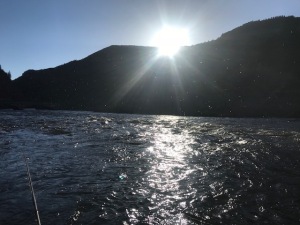
Can’t always be like this, but we can play nicely…..
The majority of anglers know fishing etiquette. Always ask folks which way they plan to fish, upstream or downstream, give them plenty of room, and extend to them the same courtesy you would expect from others. Don’t walk the banks above an angler working a run. That’s a good way to spook fish he is working. Always try to give them the run they’re in and the shelf above it. I’ll often ask if it’s ok to hit the run above them, if it’s a good distance above the shelf that marks the top of their run.
Maybe that’s part of it, folks don’t know how to read the river, which gives them no discernable start and stop places. Maybe they simply need to learn a typical run; riffle, shelf, pool, glide, tailout, riffle. Frankly, I’m not confident that will solve the issue, this comes down to a “me first” mentality. An ”I need this fish picture for my social media”, mentality. Yep, I’m still a little pissed.
I am more than annoyed at what fly fishing has become on our crowded rivers in Colorado. So many anglers, packed into a few miles of rivers. Still, I think with a healthy dose of etiquette, we could have fun days even on highly pressured waters. I have been preaching fishing etiquette for as long as I can remember, and there are days when it’s certainly more than annoying, but we have to keep teaching protocol one angler at a time. Fear No Water!
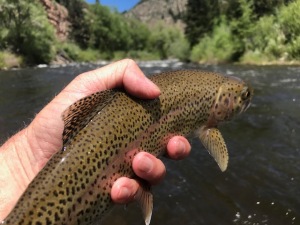
Simply remember the golden rule
Hidy Ho Good Neighbors!
Folks insinuate all of the time that as a fly fishing guide, all I do is stand in the water and bark orders. Couldn’t be further from the truth. I often will count my steps on my phone app, and I’m regularly in the six mile range when I guide six continuous hours or more. More often than that, by 9am in the morning, I’ve already sweated through my hat. Not all days are like that but those of us that wade guide hustle a bit more than folks think.
Guiding is a lifestyle and I wouldn’t have it any other way. I enjoy zipping back and forth between clients, landing fish, teaching, and yes, even untangling leader and tippet explosions. I enjoy the outdoors, sights and sounds, driving to the river with expectations, tying bugs the night before, and battling Mother Nature everyday anew. I enjoy the grind, dipping my hat in the drink because it’s so damn hot, dodging thunder storms, sunscreen burning my eyes, freezing my finger tips, the physical exertion, and the challenge. I like sitting on my tailgate behind the fly shop, guzzling a well-earned beer and smoking my pipe at the end of a long day on the river.
Couple years ago in July, and I remember it as if it were yesterday, I began the day with 3 clients from Ohio. We fished near Wolcott on the Eagle River for about six hours, and had a pretty successful outing with many fish hitting the bottom of the net. On my way back to the shop, toting my clients, I get a call from one of our managers. “Hey D, this is so-and-so, got one of your regulars in the shop, he just hit town unexpectantly and wants to know if you can give him four hours this afternoon on the river.” “Ah, sure” I reply, trying to not get my clients involved in the conversation. “Good, ok”, says my manager and he squeezes in the next words without taking a breath, “Can you hoof it?” “He has late dinner plans for tonight.” “I’m about twenty minutes out”, I say.
I love doing “doubles”, but I’m rarely prepared for that call. If I know they’re booked, it’s much easier to transition from trip to trip than finding out last minute. I had plans, like a nap, maybe go fish a bit, or hang out with my colleagues. No worries, I’ll make this happen, but I have a routine that I like to follow. I like to re-rig all of my rigs with fresh bugs and tippet the night before my next day trip. I like to go through a physical and mental checklist, I hate to be hurried prior to a trip, and I like to be at least an hour early before a guide trip. In this circumstance, I had none of those. Not only am I a creature of habit, but I’m a bit superstitious…..I have learned to not let this kind of stuff bump me off my game.
I dropped my clients off at the municipal lot down the street from the shop. Knowing my client was waiting for me at the shop, I decided to take a five minute break right where I was, and try to find something to eat and drink. My cooler revealed I had 4 waters left, one warm beer,and I was out of snacks. That’s the other thing I was going to do, hit the supermarket for drinks and goodies. Oh well, I needed to save the water for sure, but I’m thirsty as heck, “Guess I’ll pound the warm beer”, I thought out loud. I dropped the tailgate and took a good guzzle of warm suds. Just then it dawned on me, yesterday I bought a bagel at the supermarket before my trip, “Where did I leave that?”. I started rummaging through the backseat looking for that blueberry bagel. I reached under the front seat and found pay dirt. Yes, warm beer and a blueberry bagel for lunch! One of the best lunches I ever had.
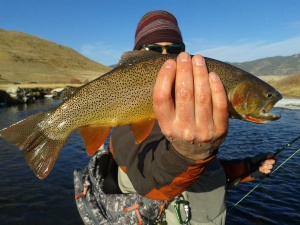
Winter spoils
I went out with my client that afternoon and we threw dry flies for about four hours. Can’t get much better than that. No, guiding is not the toughest job in the world, but it does have its challenges. Now when someone asks me how my day went, I usually reply, “I was outstanding in the river.” Ya, I know, guide humor ain’t much, but it’s better than a beer and a bagel.
The Eagle River has been fishing well this winter. Little shelf ice, clear water and active fish has made for a good start to 2018. We desperately need snow though, so if you live within 1000 miles of us, send some our way.

Butt Crack Midge for winter.
Humbled to say the book is doing well. Thanks to all of you who has purchased a copy of Hidden in Plain View. Review it on Amazon if you’re so inclined, or shoot me a note letting me know your thoughts. Thanks again!
Fear No Water!!!

Thank you!
Hidy Ho Good Neighbors!
“I probably would’ve set on that”. “I didn’t even see it move”, he replied. I said automatically, “Yea, we need to keep working on the take recognition”. All too often, I watch fish after fish eat our offerings and nothing is done on the business side of the fly rod. Doesn’t matter, it could be an eat on the swing, lift, drift or surface, and nothing happens.
I’m beyond getting frustrated with clients when they don’t recognize a fish eating their offerings; I try instead, to use it as a teaching tool. Breaking down the missed opportunity right after the fact, seems to more completely reinforce the need and timing of something that should have been set upon, than beating them over the head with it. And, like magic, once they relax and hook a few, they begin to recognize more eats and set more quickly.
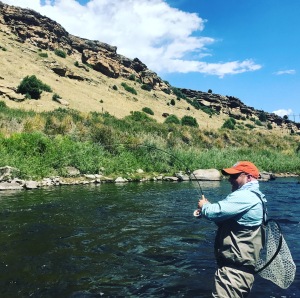
The more you set correctly, the more solid hook-ups you create….
I think most folks, even my experienced clients, that miss fish are usually preoccupied with working on another skill, and/or are overwhelmed with tougher drifts. The tougher the drift, the more mending, and the more difficult it becomes to babysit the drift. Many times clients miss takes because they are watching their hands and the fly line to ensure a good drift, and lose focus on the indicator, indicator fly (dry-dropper), or the dry fly on the surface. Sometimes, when working on advanced skills, such as, pause and go mending, folks again lose focus on the take, and miss fish. It’s easy to do.
So, how do you fix this? What do you do if you are continually missing fish? Simplify. In this case, simplification takes place in two ways: doing less while perfecting more. Perfect the ability to mend without taking your eyes off of the indicator, sighter leader, dry fly, or indicator fly. As you become more proficient at having both hands work as one, you will begin to do less, work less, and simplify the drift. So, the first simplification is teaching the hands to work together, next skill is to stop out-casting your coverage.
Out-casting your coverage begins when you have too much line out for your skill level. I believe in healthy management loops below the reel, and large slack mends if your skill level calls for it, but once you feel as if you are continually mending in your drift and can’t keep up, be honest and realize you’ve hit your limit. No shame in that, just keep working to increase your coverage. Again, simplify.

Don’t out-kick your drift ability coverage.
This sounds basic, but many folks don’t really know how to set once they do recognize an eat. All sets are not created equal. Nymph drift sets are a low sweeping motion downstream over the water. You must set the distance required to actually straighten out the line to pierce the lip. Many folks set quickly enough, but “short-set” and never straighten the line. The dry fly and dry-dropper set are usually downstream over the downstream shoulder. Much less force is applied than the nymph set because there’s not as much drag on the rig, and too much force can result in a snap-off. Be careful to set “against the fish” when setting on a dry fly, striving to set from the fish’s head to its tail. Streamer sets are completed by using your stripping hand to set the hook by pulling the management loop back toward your butt pants pocket as if you’re completing a large streamer strip. Again, these are simple sets, but require a bit of practice.
A few other tidbits: strive to learn to “vicinity set”. Try to set on any fish flash within the vicinity of your flies. For example: if you’re running a nymph rig 8 feet from indicator to your last fly, set on any fish flash within four feet of the indicator. More often than not, if you set on a fish flash within the vicinity of your drift, you’ll move a fish. If you are sight fishing, and can see the fish, learn to set on fish movement. If the fish are feeding side-to-side, set when they swing to one side and stop, before returning to their position. Same thing if fish are porpoising, set when they stop, before they go back down to their original position.
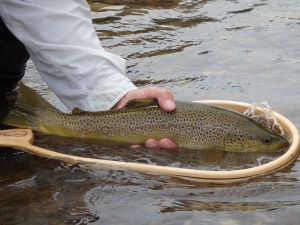
The reward after a fine battle.

There’s much more to cover here, and I go into great detail in my next book, Hidden in Plain View. The book is now in pre-sales, I think you’ll like it. It was recently the number one new fishing book, so I’m pretty pleased with that. Amazon, Barnes and Noble are offering presale discounts for a short time.
Simplify, simplify, simplify, and Fear No Water!
Duane
Hidy Ho Good Neighbors,
Angry August…..That’s fly fishing guide code for “I have to really earn my money for about three weeks”. Water flows are coming down as the air and water temperatures go up, you have a high sky, little shade and the bugs are getting smaller. It’s not terrible, but the river is a bit angry after a summer of countless boots, bugs and boats.
So, it’s a good idea to pull the staff together for some beers and brats and to recharge the staff morale a bit and go over a few late season housekeeping items. Out behind the shop, sitting on trucks and ice coolers, we assembled to go over a few tidbits and blow off a little steam that angry august can conceive.
After we went over a few items like “make sure you clean the waders”, to “if you’re gonna park here, move all the way up” to “is that my beer or yours?”, I decided to ask the guides to shout out their best current bugs. Their “crushing it” bugs like the flat-brimmers say.

T- with a fine trout that ate a brown size 18 bug….
As I sit there, my head snaps side to side as many guides bark out their current besties, and I am amazed. I hear, “size 24 thattabug” and ”size 22 everfly” ,followed by, “ a size 26 thisabug”. “What size tippet ya’ll throwin’?”, I humbly ask. “Mostly 6x flouro, nothing bigger than 5x”, many concur. Once again, I am the odd man out unless some of the other guides were feeling like me and just haven’t written it down for all to read.
I’m glad one of the crew didn’t ask me what my besties are and what size tippet I’m throwing, I would have been forced to say, “Inch a half Tan San Juan, a size 16 Partridge and Orange soft hackle, followed by size 18 Chocolate Thunder or Butt Crack”. “Uh, all on 4x,” as my voice would trail off.
I like big bugs, always have, always will, and I think if you fish them right you can maybe not hook as many fish as the small fly guys, but the ones you hook tend to stay hooked. And with bigger tippet, I don’t experience many snap-offs no matter how hard folks pinch cork. I still think the most important part of the drift isn’t always about the flies, it’s still about the drift and putting the right bugs, in the right slot, to the right fish in a stealthy manner. Are the right bugs always smaller? I don’t think so, but I must confess when the going gets tough I drop a size down to 20.
What about color? This time of year, for me, it’s about orange and brown. The fish are already looking for the big orange bodied Autumn Sedge like I am, and they have been “crushing” that size 16 softie. Brown is just a great color (purple is next) for my tricos, blue quills, pseudo baetis, and PMD emergers that are zipping around. Certainly could use other colors, but those work just fine.

Janet with a nice specimen that ate an 18 Butt Crack
I love angry August, I’ve the best job on the planet, meeting and guiding amazing people, and every now and again, I get to have a free beer and brat behind the fly shop, and that was my beer he drank out of…….
Fear No Water
Book update: Into angry August on the book too. Heavy editing begins soon, just finished illustration and photo placement. Looking forward to moving it along!
Thanks to all that voted for a cover with the link I provided last post. Hidden In Plain View reporting for duty! Soon…..

It’s Hidden In Plain View…..
Hidy Ho Good Neighbors!
Hi folks! I could really use your help in determining what the cover is to my new book that should be coming out sometime this November. It is narrowed down to two covers, and I need your votes to help decide on the cover!
Please go to the link, read the synopsis, and click on one of the covers to vote for your favorite. Please feel free to share this because I would really like a bunch of feedback.
Photo cred to Tucker Bamford and Alan Peak out of Colorado.
Thank you very much and Fear No Water!
http://www.koehlerbooks.com/cover-polls/hidden-in-plain-view-recognizing-the-obvious-exploiting-the-obscure-in-fly-fishing/
Hidy Ho Good Neighbors!
“We had our July in August” That’s what I told one of our young guns the other day before we headed to different spots on the same river. What an odd season it has been. Usually, I can somewhat predict flows and clarity pre, during, and post run-off, but this year, like last, has been confusing to say the least. July fished like August for the second straight year with somewhat picky fish, hot air and water temps, and a high sky. We were all scratching our heads as to what was going on. “Then the rains came……..”
We endured several run-offs this year. Gone are the days when you could bank on a steady, concerted melt and drain. It would start, then stop, then start again. Seems like it started in April and was done this year in late July, statistics prove that out. That lack of consistency really makes you scratch your head at times as to where the fish are holding and why. They aren’t following the typical patterns to movement because the typical patterns no longer exist. The flows this year averaged about twenty percent higher than norm until just a few weeks ago, so the fish didn’t spread out in earnest until late July. Only then did we start consistently catching fish in the faster and shallower riffles.

Fish ate a dropper in the mini rig for Thomas.
But wait there’s more! Typically, after the 4th of July, all I throw is the Mini Rig. This rig allows me to cover water from 6” to nearly 4 feet deep fairly effectively. It’s all I ever needed after the fourth all the way into late October. This year, because of flows, torrential afternoon rains, cold water temps, and funky fish holds, I found myself using the nymph rig more and more, while the Mini Rig sat idle on the bank. Gotta fish ‘em where they’re feeding consistently, so nymphing ruled the day until about two weeks ago.

One of the last nymphed fish this season.
Now the flows are perfect, the water is gin clear, and small quills and tricos are coming off. It’s been a Mini Rig domination the last two weeks, backed up by double dry rigs and an occasional streamer or nymphing rake. Back right where she should be, even though temps hit the mid-thirties a couple mornings last week. I’ll take it, means fall is on the way, big orange sedges, trico spinner falls, pseudo-baetis, and hoppers on the edges. Plenty of water this year, so I guess it’s ok to have that many run-offs after all. Mama Nature knows what she’s doing.

Eric with a fish that ate a dry. Cherry series 8′ 4wt- 8 Rivers Fly Rods
Just a couple quick notes:
I am building next year’s speaking schedule, so if you know of any club or organization looking for a fly fishing speaker feel free to contact me.
Hidden In Plain View is going well. I am knee deep into the photo and illustration portion, and loving every minute of it. Looks like a mid November completion date.
And lastly,
The Butt Crack baetis made it into the Montana Fly Catalog. It’ll be available, along with the Butt Crack Midge, early next spring.

Butt Crack baetis- My go to fly most of the year…..Coming to a fly shop near you!
Fear No Water!
“Alright, let’s get started”, someone with authority barks, but I’m already seated up toward the front. “How did I get here?”, I muse as I realize I am front and center. I quickly scoot myself back toward a wall during the confusion of folks jockeying for chairs and finding their comfy places. Our manager welcomes everyone and decides we should do introductions as there’s new faces in the crowd. There’s always new faces, where do these folks come from?

Oldest guy in the room.
The guy with a beard to my right starts, “I’m so and so and this is my second year”, then it’s the other guy with a beard, “I’m so and so, and this is my first year, then it’s the fresh faced young woman, “I’m so and so, this is my first year. Uh-oh, my turn, “I’m Duane, ah this is my first year.” That gets a laughing response from the masses, because they all know I’m the old guy. The roll-call continues and the bearded guys keep rolling out low numbers of years with guiding experience. I’m amazed. Yea, there’s a few with eight or nine years in the room (one that says he shadowed me 8 or 9 years ago), but for the most part these folks are young enough to be my kids. Hell, some of them might be.
It’s like going to a professional baseball game and realizing that the damn umpires are younger than you. I’m the oldest in the room again, and after some health issues last winter, I’m beginning to feel it. Don’t get me wrong, I can hang with these kids all day everyday, it’s just that when I grow a beard, it’s gray. That just doesn’t look cool in a fly shop or magazine cover anymore. I’m a relic, and my fly choices and approach to the sport show it. I still throw tons of soft-hackles and my idea of lunch is sandwiches on the way to the river so we have optimal time to fish. Although I still throw softies, I have had to learn that guide trip lunch is something you do sitting down next to the river after you have thoroughly washed your hands with that new antibacterial liquid soap. Isn’t all soap antibacterial?
I digress. As the paper stack grows at my feet, I wonder how many old permits are in my pack. Not too long ago, I was stopped by a game warden and checked for a license. I found one in there from 2007, I really need to get in there and clean my pack out. Might be a sandwich in there. The manager explains how to carry these in a water-proof bag in your waist pack (no vest wearers in this room, not since I switched 5 years ago.), and I watch as some folks jot down this information, and the most of the rest are nodding their heads in agreement. I think, “You gotta be told how to carry this stuff?”. Then, I kick myself for being “that old guy”, and find myself nodding with the rest.
I’m asked to get up and describe the areas we can legally guide on the South Platte River near Deckers. I get up and in a nice way tell them it is their responsibility to learn where they can and can’t fish. I go into how one winter, I walked the entire blue line from the confluence up to the fly shop, and drew a map showing every feature I thought important. I realize at this time that I wasn’t asked to tell them to learn it themselves, so I explain that we can meet down there and do a drive-a-long. Old guy relinquishes again, but it’s worth it.
I also throw in that there are a million first year guides out there, but not nearly as many second year guides. In other words, don’t be a jerk, keep your head down, and bust your ass. As the meeting comes to a close, I think about how these guide meetings are just like the first day of school. A good chance to meet new people, rekindle old friendships, discern a pecking order, and fill out a pile of paperwork. Just before the meeting was adjourned I got “it”. I got that old feeling that I used to get before a guide trip, or when geese were set and coming in to my decoys. or before a big baseball game. I got a butterfly. Only one, but it was a good one. I’m excited for another year on the river. I look for the challenges, and am stoked about working with all of the guides, management, and ownership. Here we go.
Fear No Water
p.s. Buy a copy of The Fly Fishers Playbook for the old guy in your life for Father’s Day
Hidy Ho Good Neighbors!
Wow, been too long since I last posted, but I’ve been a busy dude. Just spent the last eight to ten weeks cranking out the text for my next book project. I’m really fired up about this book, and am looking for an on the shelf date of late 2017. The text is done except for countless edits, but that’s never been the hard part for me. The hard part is all of the charts, graphs, illustrations and pictures. Going to rely on some talented friends to help out with all of that. Speaking of friends, I asked four from around the country, at various stages of their perspective fishing careers to read and edit for flow, content, etc. I really appreciate their help, and they will have special mention in the book.
First book was out on June of 2011, second came out in December 2014, this one hopefully, in December 2017. Notice a pattern there? What it tells me is that it takes me about three years to learn enough new stuff to be able to write another book. That’s thousands of hours of on the water observations, note taking, and data collection. I was on the river yesterday and someone shouted to me the river temperature, and I honestly didn’t care. Oh, I will in a couple of weeks when the Blue Wings start popping, but yesterday was a diversion from the book day, so I simply nodded it off.
I am still amazed at what I glean from simple water time in a relatively short time. It shows I’m paying attention AND there’s still more to learn! A lot more! This next book uses statistical information from hours and hours of dedicated note taking to flesh out the best techniques and flies to use as you progress on your fly fishing journey. It’s going to be roughly 55,000 words, plenty of illustrations and pictures should round it out. This years presentation is called Hidden In Plain View, and folks across the country seem to like it. The presentation mirrors the book as it gets into being able to recognize the obvious and exploit the obscure in fly fishing. It should have something for every level angler, and covers tactics from mini/skinny, double dry fly, nymphing, and streamer work. Crazy fun.
So, with all that going on, I haven’t had much time to work on my annual winter technique. Most that have followed for a while will recall that I pick something to work on every winter during slack times in the season. This year, I decided to continue what I was working on last winter and last 2 years guiding seasons. I’ve been working on this covertly, simply because I didn’t feel as if it was ready to unveil. It’s no mind blasting technique, but I wanted to have the specifics dialed in before telling anyone about it. In the last three years I have begun to use “sighter” leaders in my suspended or hinged nymph rigs. A sighter leader allows the angler many benefits, but mostly for this indicator fishing it helps detect very subtle eats, and it gives you a great idea of what your rig is doing sub-surface in relation to your indicator. It’s a specialized leader I build using various poundages and colors of amnesia and monofilament lines. A few of the knot tags are left un-trimmed and further the sight capabilities.
Many anglers don’t even realize what is going on sub-surface in regards to the indicator. We are so dialed into surface mending, that we don’t think about subsurface mending. We can see what is going on surface wise because of our fly line, but it’s often difficult to discern what is going on below the indicator. The sighter leader fixes that because it will clue you in as to when your leader turns over the indicator, and where your flies are at pretty much anytime within the drift. This has been a huge help to many of my clients as they begin to see how a few specialty mends can effect the entire sub-surface drift. They then can learn and employ a pile, stack, or pause mend with great effectiveness and confidence, because the results are observable through the sighter.
Here’s the formula for one of my leaders, this is all you get til the book comes out! Try this, I think you’ll like it:
36″- 20 pound Yellow Amnesia
30″ – 14 pound clear Monofilament
24″ – 10 pound Red Amnesia
Connect everything with a blood knot, and if you wish use a tippet ring at the end of the 10 pound red amnesia, it’s a fine idea. From the tippet ring attach your 16″ of 4x, 5x, or whatever mono or flouro to your first fly. You can place your split shot above the tippet ring to complete your in-line nymph rig.

Upstream sighter leader work. Photo James Durden.
I was fishing this rig just yesterday and noticed and set on the sighter movement more than a few times. The indicator never even twitched. It does take a bit of practice to use the sighter because it forces you to keep the indicator in your peripheral vision and use it as a secondary device. This just adds to your angling versatility as you begin to fish the entire vicinity around the nymph rig.
Anyway, enough for now. I’ll be better with more consistent posts. Til then, get out and fish the sighter.
Fear No Water!

Notice the blood knot tag location…mono to red amnesia line.
Hidy Ho Good Neighbors,
“He ate”, I said. “Really, I never even saw it”, he replied. Recognizing a fish taking your dry fly is not always the stuff that movies are made of. Sometimes, it is so subtle that we miss the take. Fish typically don’t eat dries while you’re zoomed into the frame in super slow motion with music playing in the background. It’s typically a game of controlled speed, technique, and yep, luck.
It’s obvious we don’t know what we’re missing while nymphing because stuff is going down sub-surface. I imagine there are several fish we “miss” and don’t even know they ate. Same holds true for surface fishing, but actually seeing the misses is much easier and certainly more frustrating. Just last week I had a client set up doing some quarter upstream double dry work. He was rolling an Elk Hair Caddis 18” ahead of a Yellow Sally. The fish were gorging on both. He surmised that for every 10 fish that ate his offerings, he may turn 3, and for every 3 he turned he may solidly hook 1. And this guy is a good stick, honest too.
Last week, it was easy to tell when a fish ate the dries as most takes were splashy. That’s the telltale sign fish are eating caddis, stones, or terrestrials. Not a hard and fast rule, like all in fly fishing, but when you’re seeing aggressive, splashy takes, good bet they’re eating something that skitters, flutters, or bounces on the water. When you see those easy, simple rises, fish are usually secure, calm, and eating duns, spents, or cripples. In all cases you need to read the fish, the bugs, as well as the river to dial in the correct offerings.
Let’s talk more about reading fish as they eat dries. There are basically, 3 types of rises; simple, compound, and complex. In each case the fish have a staging spot, or a beginning holding area. In a simple rise, the fish typically simply elevate to the surface, break the surface, and yawn in the bug. A compound rise is a bit more detailed as the fish, starting in the same staging area, follows the bugs for a short distance before ingesting. This is a tough rise to consistently hook fish because they are really inspecting your flies, and any wrong move means game over. The last type of rise is a complex rise. These fish do the same as a compound except they actually turn downstream and follow your bug downstream. Usually, if you can maintain your drift, that fish will eat.
The key to dry fly presentation when it comes to how the fish are eating is observation. Watch how the fish are feeding, where they are staging, and then cast 4 to 5 feet upstream of them. Show the flies only, no fly line allowed. I see a lot of folks that have a surface feeding fish picked out and either cast way too far upstream, or cast directly on top of the fish. If you take a nymphing cast approach and cast way upstream, you will have a terrible time keeping your drift as you near the fish strike zone. Casting on top of the fish that is eating a full 4 feet downstream of where it’s staging causes issues too if you cast 4 feet above where you saw it eat. I’ll let you digest this for a minute.
Couple things about the dry fly lift. Not even gonna call it a set. It’s a lift in the opposite direction that the fish ate. Fish eats going downstream (complex rise), you lift upstream. Simple rise upstream of you, you lift up and downstream. Lift speed is not nearly as critical as lift direction and control, and this is how most fish are missed when dry fly fishing.
That’s enough for now. Hey, if you don’t already, please like The Fly Fishers Playbook Facebook page. Only fly fishing, and plenty of it.
Fear No water!

Dry fly fishing in beautiful places….

Size 18 Elk Hair caddis
























